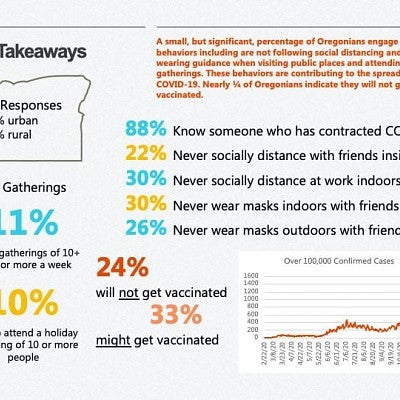Nine months into a deadly global pandemic that continues to affect all corners of Oregon, a small but significant number of state residents are unwilling to follow basic guidelines such as wearing a mask and maintaining social distance.
Those are among the findings of a survey of Oregon residents about COVID-19 masking, social distancing and vaccines that was released in late December by a pair of UO researchers.
“By not following state guidance when visiting public places and attending social gatherings, these behaviors are contributing to the spread of COVID-19,” said Benjamin Clark, one of the study’s authors and co-director of the Institute for Policy Research Engagement.
Bob Parker, the recently retired executive director of the Institute for Policy Research Engagement at the School of Planning, Public Policy and Management, co-authored the study with Clark.
Also among the findings: 24 percent of respondents said they will not get vaccinated for COVID-19 and 33 percent said they “may” get vaccinated.
“This should scare all of us,” Clark said.
“In Oregon, the most common reason pushing people to say no or maybe to the vaccine are concerns about side effects,” added Clark, a professor in the School of Planning, Public Policy and Management, part of the UO’s College of Design. “What is more concerning is that about 15 percent of folks think you can get COVID-19 from the vaccine itself. You cannot.”
Parents of kids younger than 18 are more likely to say no to a vaccine for COVID-19. They also have plans to get vaccinated at a slower rate than people who do not have kids under 18.
COVID-19 has touched nearly all those who took part in the survey, with 88 percent saying they know someone who has contracted COVID-19. Seven percent of urban residents and 9 percent of rural residents report having already had the virus.
Despite that, 22 percent never socially distance inside with friends, 30 percent never wear masks inside with friends, 26 percent never wear masks outdoors with friends, 30 percent never socially distance when at work indoors, and 11 percent attend gatherings of 10 or more at least once a week.
“Rural residents indicated that they are socially distancing less — a lot less — in a lot of different settings,” Clark said.

Clark and Parker asked in their survey about which sources respondents trusted most for their information about COVID-19. In both rural and urban parts of the state, local news stations and newspapers were viewed as being most trustworthy along with Oregon Public Broadcasting and National Public Radio. Oregonians also largely trust the Oregon Health Authority and local public agencies.
“Pretty much every other source is not trusted,” Clark said.
The researchers also offer recommendations, including that communications should continue to focus on the size and frequency of gatherings, as groups of 10 or more gathering unmasked indoors is a known source of community spread.
They also recommend using combinations of the most trusted information sources to switch individuals who say they are opposed to receiving the vaccine or are undecided to yes. They also recommend directly addressing the disinformation campaigns that appear to be influencing those individuals in the communications.
“The effect of this disinformation should be addressed early and often by trusted sources,” Clark and Parker wrote.
Additionally, messaging should address specific areas of concerns, like side effects of the vaccine, that you cannot get a disease from the vaccine, and that vaccines do work and why.
Clark and Parker also found that the individuals who have indicated they are not planning on getting vaccinated also are the same individuals who indicate they are gathering in groups that are unsafe and will lead to greater spread of COVID-19.
—By Jim Murez, University Communications


